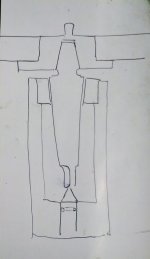I believe that was a fault of the AC wall connected AC synchro motor, adding the controller sorts that.
dave
Yet funny how everyone else who sold turntables with AC syncro motors at the time made them run at the right speed. A cynic might say it was done on purpose to make the tables sound different on demo. That or shonky engineering to maximise profit.
I can't help thinking that Eric Laithwaite could come up with a novel solution ( I have no idea if he's still with us ), probably some mag levitation thing with a " linear " ( but in an ark ) motor acting on a copper flange around the plater. If I was in the market for a turntable, I'd go for a cheap ( £300 ish ) Lenco direct drive, but I found a Gerard 401 at a junk shop for £10 - when I realized it's value I snapped it up and carried it home with a fractured arm, it rumbles though, so I'm guessing the idler rollers gone. I see the problem with most belt drives is that it's just a stretchy bit of rubber, I can't help thinking that cotton or Kevlar cords in the belt would improve speed stability.
Eric Laithwaite, who I met on several occasions as a student in the 1970s, is no longer with us. Died in 1997.
He was very good company, but could be controversial in the company of other academics. He and others had a right old friendly bargy over dinner one evening, I was there. That was later in his career when he was interested in Gyroscopics rather than linear motors. Some did not agree with his maths after a demonstration at a uni Physics Society. I was the poor shmuck at the front of the lecture theatre in that demo, waving a long arm with a rotating wheel at the end. On linear motors, my Uni had a test track running a full scale model of his linear motor powered train. Some of my engineering practicals were in the same space.
Yet funny how everyone else who sold turntables with AC syncro motors at the time made them run at the right speed. A cynic might say it was done on purpose to make the tables sound different on demo. That or shonky engineering to maximise profit.
Could be the old 'promote and get it out there first, debug later' ethic. Rega would not be unique in this regard.
AC synchronous motors in some vintage turntables are known to "run slow" due to old lubricant gumming up in the sintered bearings, and in other cases of the ring magnet losing some of its magnetism, making it harder to "lock into" sync.
I've come across enough of them over the years to know this.
I've come across enough of them over the years to know this.
If I was going to make a decent deck, I'd use a 3mt to a jacobs taper arbor or the spindle , they're cheap and precision made and should be available for many years to come should a replacement be required. I'd use the 3 morse taper for the bearing surface ( with a center for the thrust and to adjust clearance ) and the Jacobs taper to locate the sub plater. I don't like the thought of the flywheel effect of a motor coupled to the flywheel effect of the platter by a rubber belt, I'll agree that I think of a magnetic field as springy, but clever people can do clever things with motors.
Both tapers are locking tapers, that's why you can use them on a drill, mill or lathe.
Last edited:
Are the peaks in the 1 KHz spectrum in fig. 1+2 (Linn LP-12) underAC synchronous motors in some vintage turntables are known to "run slow" due to old lubricant gumming up in the sintered bearings, and in other cases of the ring magnet losing some of its magnetism, making it harder to "lock into" sync.
I've come across enough of them over the years to know this.
https://www.stereophile.com/content/linn-lp-playing-system-measurements
an indicator for this occurred unwanted effects due aging (have a look to fig. 3 without such peaks - this is a plot of Pioneer's DD "PL-L1000") ?
You know, you should be comparing systems that work properly. When a synchronous motor is locked to the line frequency it is pretty stable. Now what matters is the rotating mass and bearings - assuming a good tonearm set up reasonably well.
I prefer a great belt drive turntable for the simple reason that direct drive tables typically have lighter platters and the bearings are typically not great. Then there is the tone arm ... For me, a Thorens is as good as you're going to get. A Linn costs far too much, and the power supply / motor driver unit was defective in design *** as far as I'm concerned should be a free warranty replacement. But no! They sell it as an "upgrade". For me the TD 1601 is the current leader. You can dump a ton of money if you want, but have fun topping this performance. Even the factory arms are top performers. I have a TD-125 MKII and a TD-126 MKII, both original arms (I've had to source and install original arms for others to get the best performance). The 126 is by far the nicest table I have owned and I have tried many. (want a new Thorens). The belt drive tables have lower rumble and lower speed variations than the DD tables I have tried with large modulation changes. Additionally, a slightly tacky mat really helps and absorbs noise from the record itself. No, it does not affect the bass at all. Neither does a different power supply on a Linn (referring to the review linked to above).
Been doing this since the 1970's. Sold tables in a HiFi shop then too. I've seen them all so I'm just reporting observations.
I prefer a great belt drive turntable for the simple reason that direct drive tables typically have lighter platters and the bearings are typically not great. Then there is the tone arm ... For me, a Thorens is as good as you're going to get. A Linn costs far too much, and the power supply / motor driver unit was defective in design *** as far as I'm concerned should be a free warranty replacement. But no! They sell it as an "upgrade". For me the TD 1601 is the current leader. You can dump a ton of money if you want, but have fun topping this performance. Even the factory arms are top performers. I have a TD-125 MKII and a TD-126 MKII, both original arms (I've had to source and install original arms for others to get the best performance). The 126 is by far the nicest table I have owned and I have tried many. (want a new Thorens). The belt drive tables have lower rumble and lower speed variations than the DD tables I have tried with large modulation changes. Additionally, a slightly tacky mat really helps and absorbs noise from the record itself. No, it does not affect the bass at all. Neither does a different power supply on a Linn (referring to the review linked to above).
Been doing this since the 1970's. Sold tables in a HiFi shop then too. I've seen them all so I'm just reporting observations.
Properly maintained tables will not show issues and it makes zero sense comparing things not in good repair.
Generally speaking, if you have a high rotating mass and good bearings, you will not see these peaks. Once you start comparing using an LP and tonearm / cartridge you may see all kinds of effects. A modulated record surface is a noisy thing, lots of vibrations through the vinyl that need to be damped (the job of the record mat). The wrong mat and you have a very lively - noisy surface. So attempting to compare drive systems this way has a lot of uncontrolled factors. So what makes a good test? Controlling everything except the variable you are studying.
An observation if I may from being in the industry since the 1970's. Belt drive tables (decent ones) typically have heavy platters and great bearings. The belt decouples the drive system from the rotating mass. Wrong belt and you may have increased coupling between the drive system and platter (not good). A wider or stiffer belt does this every time. Thorens makes about the best table and has for decades. Linn is very good but at a ridiculous cost. Plus the defective design of stock motor drive should be a warranty replacement but is sold as an upgrade (talk about greed!). As a note, the stock Thorens arm on each table is the best matched, and is an extremely good arm. My two tables both sport the factory arms with very expensive cartridges, two entirely different models.
Direct drive tables really work best with light platters, or they need an advanced drive system design to ramp up the drive so they don't overheat with a heavy platter. The typical DD table is a cost and advertising deal and built to a lower cost point. Lower mass platters are lighter (of course!) and cost less to ship, plus the bearing can be lighter. Factory arms are also typically "less good" (read unacceptable) than replacement arms. As a result your rumble and other drive noise will read higher levels, although there is no excuse for the speed to vary except under sudden high modulation. This is where a high mass platter really shines.
The mat. Critical, it absorbs vibrations in the record, and it (if tacky) keeps the record from slipping while also damping acoustic vibrations. The very best mat I ever found was a "Platter Matter" and I would buy a new one if they recreated them. I use a Mike's mat now, the closest thing and it performs much better than other types of mat. Another note. A tacky mat has zero effect on bass. It cleans everything up immensely as you might expect. To reduce bass, you would have to reduce the amount of motion in the stylus, and that isn't physically possible folks. If anything, a tacky mat increases stylus motion to the modulated groove for the intended signal (again, not a surprise). It forces the record to remain motionless with respect to the platter. This is exactly what you want.
I find most reviewers have a weak grasp of physics and merrily report things that are not possible if you think about it for even a short time (assuming you understand the laws of motion). The drivel that is out there astonishes me. They actually get paid for this!
-Chris
Generally speaking, if you have a high rotating mass and good bearings, you will not see these peaks. Once you start comparing using an LP and tonearm / cartridge you may see all kinds of effects. A modulated record surface is a noisy thing, lots of vibrations through the vinyl that need to be damped (the job of the record mat). The wrong mat and you have a very lively - noisy surface. So attempting to compare drive systems this way has a lot of uncontrolled factors. So what makes a good test? Controlling everything except the variable you are studying.
An observation if I may from being in the industry since the 1970's. Belt drive tables (decent ones) typically have heavy platters and great bearings. The belt decouples the drive system from the rotating mass. Wrong belt and you may have increased coupling between the drive system and platter (not good). A wider or stiffer belt does this every time. Thorens makes about the best table and has for decades. Linn is very good but at a ridiculous cost. Plus the defective design of stock motor drive should be a warranty replacement but is sold as an upgrade (talk about greed!). As a note, the stock Thorens arm on each table is the best matched, and is an extremely good arm. My two tables both sport the factory arms with very expensive cartridges, two entirely different models.
Direct drive tables really work best with light platters, or they need an advanced drive system design to ramp up the drive so they don't overheat with a heavy platter. The typical DD table is a cost and advertising deal and built to a lower cost point. Lower mass platters are lighter (of course!) and cost less to ship, plus the bearing can be lighter. Factory arms are also typically "less good" (read unacceptable) than replacement arms. As a result your rumble and other drive noise will read higher levels, although there is no excuse for the speed to vary except under sudden high modulation. This is where a high mass platter really shines.
The mat. Critical, it absorbs vibrations in the record, and it (if tacky) keeps the record from slipping while also damping acoustic vibrations. The very best mat I ever found was a "Platter Matter" and I would buy a new one if they recreated them. I use a Mike's mat now, the closest thing and it performs much better than other types of mat. Another note. A tacky mat has zero effect on bass. It cleans everything up immensely as you might expect. To reduce bass, you would have to reduce the amount of motion in the stylus, and that isn't physically possible folks. If anything, a tacky mat increases stylus motion to the modulated groove for the intended signal (again, not a surprise). It forces the record to remain motionless with respect to the platter. This is exactly what you want.
I find most reviewers have a weak grasp of physics and merrily report things that are not possible if you think about it for even a short time (assuming you understand the laws of motion). The drivel that is out there astonishes me. They actually get paid for this!
-Chris
Interesting observations. According my experiences a similar rubber mat (no name) provide best results - if the mat, that you mean is according those from the attachments.The mat. Critical, it absorbs vibrations in the record, and it (if tacky) keeps the record from slipping while also damping acoustic vibrations. The very best mat I ever found was a "Platter Matter" and I would buy a new one if they recreated them. I use a Mike's mat now, the closest thing and it performs much better than other types of mat. Another note. A tacky mat has zero effect on bass. It cleans everything up immensely as you might expect. To reduce bass, you would have to reduce the amount of motion in the stylus, and that isn't physically possible folks. If anything, a tacky mat increases stylus motion to the modulated groove for the intended signal (again, not a surprise). It forces the record to remain motionless with respect to the platter. This is exactly what you want.
-Chris
The term "Mikes's Mat" don't provide results.
Interesting to know concerning sound character would be this mat:
https://www.hifi4sale.net/t55695-sph-stainless-steel-mat-on-my-lenco-l78
Attachments
-
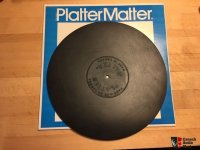 2404091-07f6cd88-platter-matter-turntable-mat.jpg39.1 KB · Views: 78
2404091-07f6cd88-platter-matter-turntable-mat.jpg39.1 KB · Views: 78 -
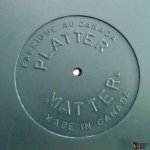 1282665-4d02e4a2-original-platter-matter-turntable-mat-made-in-canada.jpg73.9 KB · Views: 319
1282665-4d02e4a2-original-platter-matter-turntable-mat-made-in-canada.jpg73.9 KB · Views: 319 -
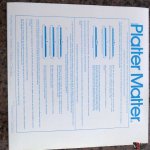 1282668-633f2fba-original-platter-matter-turntable-mat-made-in-canada.jpg108.2 KB · Views: 81
1282668-633f2fba-original-platter-matter-turntable-mat-made-in-canada.jpg108.2 KB · Views: 81 -
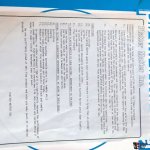 1282666-9ada1b4f-original-platter-matter-turntable-mat-made-in-canada.jpg125.6 KB · Views: 77
1282666-9ada1b4f-original-platter-matter-turntable-mat-made-in-canada.jpg125.6 KB · Views: 77 -
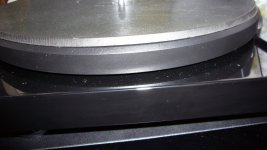 L1040755.JPG.ee123e1e15728576602900a2ca98d82a.jpg196.9 KB · Views: 70
L1040755.JPG.ee123e1e15728576602900a2ca98d82a.jpg196.9 KB · Views: 70 -
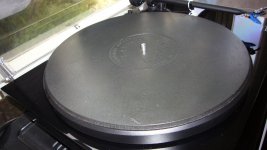 L1040756.JPG.91023dfbeaa83943988b0b668037c431.jpg196.4 KB · Views: 67
L1040756.JPG.91023dfbeaa83943988b0b668037c431.jpg196.4 KB · Views: 67
The one i have on my Rega. Also a light weight Corian platter.
Chris and i have had discussions on TTs, and he & i don’t see eye to eye. If i had the cash to afford the TT i’d like is the Rega 10. Greta efforts to reduce the mass of everything.
He would be appauled at teh (literally) 100s of TP16s we tossed n the trash.
dave
After compare against a motor control unit from German's company DBF I think so, too.A Linn costs far too much, and the power supply / motor driver unit was defective in design *** as far as I'm concerned should be a free warranty replacement. But no! They sell it as an "upgrade".
https://www.diyaudio.com/community/...ine-wave-oscillator-for-motor-control.212688/
https://www.diyaudio.com/community/...-description-wanted-for-sine-wave-osc.345811/
Actually the reason for the better results is the fact, that Linn's motor control units (both Lingo and Valhalla) uses a square wave oscillator and an integrator for converting in a sine wave oscillator (obviously a disadvantage) and the Dr. Fuß (DBF) motor control use a sine wave oscillator (created by a state variable filter, check out pdf attachment in post #16).
Hi TT,
Nothing wrong with a filtered square wave at all. Absolutely nothing. The motor control stock is defective in design, period. FOr what they charge and the cost of teh electronics they can easily afford to use the top end unit. Marketing.
The only thing the motor driver has to do is provide a stable in frequency and amplitude signal - that is all. Anything said beyond that shows a complete lack of understanding of how things work.
-Chris
Nothing wrong with a filtered square wave at all. Absolutely nothing. The motor control stock is defective in design, period. FOr what they charge and the cost of teh electronics they can easily afford to use the top end unit. Marketing.
The only thing the motor driver has to do is provide a stable in frequency and amplitude signal - that is all. Anything said beyond that shows a complete lack of understanding of how things work.
-Chris
Hey Dave,
Yes, I know you guys threw out a ton of rather excellent TP-16 tone arms. What a shame, the audio industry has long ignored the reality of things and it shows year after year.
You have got to see the current Thorens tables. If I had the money I would buy one in a heartbeat! I have seen them, they are amazing!
We do agree on the Platter Matter though! How do you get the sticky back? I still have two.
-Chris
Yes, I know you guys threw out a ton of rather excellent TP-16 tone arms. What a shame, the audio industry has long ignored the reality of things and it shows year after year.
You have got to see the current Thorens tables. If I had the money I would buy one in a heartbeat! I have seen them, they are amazing!
We do agree on the Platter Matter though! How do you get the sticky back? I still have two.
-Chris
anatech,
your comments about D/Ds are hilarious. There are so many Japanese D/D superdecks from the 70s and 80s that make a nonsense about your description of them. Did you ever sell Trio/Kenwood or a host of other great Japanese D/D. The latest SME (very expensive) deck has inferior specs. form the 80s' Kenwood decks.
Built down to a price, crappy bearings LOL. Check out the Kenwood KD/KP series. The bearing system because that is what it is makes the European/American belt drives appear like knuckledraggers compared to spacemen. The KD series has an alloy steel cylindrical rod which is rifled. It sits on a massive nut that is mirror finished. When you try to extract this rod to clean off the old slick 50 oil it is difficult because the tolerances are so tight, any tighter and it would be impossible because the rod rotates inside a cylinder and effectively the bearing surfaces are the base and the interface between the rod and cylinder. The mains Tx is suspended from rubber grommits. The platter is a heavy die caste affair with an excellent sintered rubber mat, no need to waste money on the latest expensive piece of b/s to replace it.
My first experience of D/d was a s/hand Technics SL120 with an SME 3009 detachable h/shell. I had bought it for my then partner in 1999. I had been rained off (outdoor work) so set it up on a wall shelf bracket. I can't remember now what the cartridge was or what I played but the difference in playback quality compared with a Rega 3 was so obvious. It made the Rega 3 sound like the crap it was. The Kenwood was silent, so much detail had been obscured by the crappy belt drive.
On the rec. of an industry professional on the old WAD forum I shelled out for the Kenwood KD990 which came with what the professional said was one of the best gimbal arms, an absolute doddle to set up. It also had what none of the belt drives had or even the hugely expensive eye candy decks of today - arm lift at end-of-side and motor shutdown neither of which has any negative impact on the sound. This arm lift has meant that there are no scratching of the LP returning the arm to it's rest position.
This pro supplied a list, not definitive of all the Japanese superdecks, I think it was about 10. On the WAD forum I was mercilessly attacked by the Garrard fanatics because the Kenwood was plug and play.Some spent fortunes on double slate plinths, replacing the primitive bearings, fast forward - all of them dumped the Idlers and replaced with yes you've guessed it - Japanese D/Ds and not one had the balls to apologise.
You specifically mention the belt drives but do not name the 'inferior D/Ds - why not?
your comments about D/Ds are hilarious. There are so many Japanese D/D superdecks from the 70s and 80s that make a nonsense about your description of them. Did you ever sell Trio/Kenwood or a host of other great Japanese D/D. The latest SME (very expensive) deck has inferior specs. form the 80s' Kenwood decks.
Built down to a price, crappy bearings LOL. Check out the Kenwood KD/KP series. The bearing system because that is what it is makes the European/American belt drives appear like knuckledraggers compared to spacemen. The KD series has an alloy steel cylindrical rod which is rifled. It sits on a massive nut that is mirror finished. When you try to extract this rod to clean off the old slick 50 oil it is difficult because the tolerances are so tight, any tighter and it would be impossible because the rod rotates inside a cylinder and effectively the bearing surfaces are the base and the interface between the rod and cylinder. The mains Tx is suspended from rubber grommits. The platter is a heavy die caste affair with an excellent sintered rubber mat, no need to waste money on the latest expensive piece of b/s to replace it.
My first experience of D/d was a s/hand Technics SL120 with an SME 3009 detachable h/shell. I had bought it for my then partner in 1999. I had been rained off (outdoor work) so set it up on a wall shelf bracket. I can't remember now what the cartridge was or what I played but the difference in playback quality compared with a Rega 3 was so obvious. It made the Rega 3 sound like the crap it was. The Kenwood was silent, so much detail had been obscured by the crappy belt drive.
On the rec. of an industry professional on the old WAD forum I shelled out for the Kenwood KD990 which came with what the professional said was one of the best gimbal arms, an absolute doddle to set up. It also had what none of the belt drives had or even the hugely expensive eye candy decks of today - arm lift at end-of-side and motor shutdown neither of which has any negative impact on the sound. This arm lift has meant that there are no scratching of the LP returning the arm to it's rest position.
This pro supplied a list, not definitive of all the Japanese superdecks, I think it was about 10. On the WAD forum I was mercilessly attacked by the Garrard fanatics because the Kenwood was plug and play.Some spent fortunes on double slate plinths, replacing the primitive bearings, fast forward - all of them dumped the Idlers and replaced with yes you've guessed it - Japanese D/Ds and not one had the balls to apologise.
You specifically mention the belt drives but do not name the 'inferior D/Ds - why not?
Check out the Kenwood KD/KP series.
Once owned an L-07. Apart from sounding mediocre compared to my other tables at the time, it also employed some questionable engineering decisions. At some stage the pcb which supported the main bearing (!) got out of shape and the platter sagged a bit lightly scraping the copper coils underneath at each rev. Good thing i opened it up on time as the platter was beginning to eat through the wire enamel.
The lack of suspension combined with high mass made it extremely picky towards placement.
Hi Black Stuart,
You have obviously no clue as to who you are talking to. That's cool.
I have direct experience with just about every table made. Yes, you can built a DD table as good as a belt drive table. As I mentioned you need to think carefully about the DD motor and ramp up the speed to spin a heavy platter. The fact remains you need a heavy rotating mass (within reason) and an excellent bearing. Suspension comes into play as well of course. Then there is the mat.
If you focus on the basics and apply those to what is on the market the answer is pretty clear. Ignore marketing hype and unsubstantiated opinions. I haven't got anything to prove and I am simply reporting observations. So instead of attacking me, use your head for more than a hat rack and do some actual studying. Experience might help you a great deal. I have over 45 years of experience in the audio field, plus in the test and measurement field. I have over $100K on my current test bench, lots of new Keysight equipment. I am currently working in the audio field, not a hobbyist although audio is also an interest.
-Chris
You have obviously no clue as to who you are talking to. That's cool.
I have direct experience with just about every table made. Yes, you can built a DD table as good as a belt drive table. As I mentioned you need to think carefully about the DD motor and ramp up the speed to spin a heavy platter. The fact remains you need a heavy rotating mass (within reason) and an excellent bearing. Suspension comes into play as well of course. Then there is the mat.
If you focus on the basics and apply those to what is on the market the answer is pretty clear. Ignore marketing hype and unsubstantiated opinions. I haven't got anything to prove and I am simply reporting observations. So instead of attacking me, use your head for more than a hat rack and do some actual studying. Experience might help you a great deal. I have over 45 years of experience in the audio field, plus in the test and measurement field. I have over $100K on my current test bench, lots of new Keysight equipment. I am currently working in the audio field, not a hobbyist although audio is also an interest.
-Chris
Chris, I recently restored a cosmetically perfect TD-124 for my neighbor.Hey Dave,
Yes, I know you guys threw out a ton of rather excellent TP-16 tone arms. What a shame, the audio industry has long ignored the reality of things and it shows year after year.
You have got to see the current Thorens tables. If I had the money I would buy one in a heartbeat! I have seen them, they are amazing!
We do agree on the Platter Matter though! How do you get the sticky back? I still have two.
-Chris
It needed extensive 'under the hood' service, and had a seized-up motor, and was fitted with the Grado wooden tonearm/F1 cartridge.
My neighbor was thrilled with the results.
So.... this week he brings me yet another one to work on!
This one's missing some parts from the Grado arm, namely the counterweight.
And in decent but not stunning shape as the previous one.
Hmmm, old parts like that are difficult if the manufacturer / distributor doesn't have them. Sometimes you can get lucky with an old authorized warranty repair shop. Missing arm parts are rather common with unused tables.
Personally speaking, the factory arm with really good tables are often better than after market arms. In the case of an ancient table like a 124 you can get better arms, but you have to be very careful. One huge advantage a factory arm has is that everything has been designed with that table in mind. Of course you have to match the cartridge with the arm characteristics too, you can't just grab what people think is the "best cartridge" and stick it on "the best arm".
With the old tables I still would rather stick the original arm on it. Cheaper tables ... well. Open season as they were never great and all you can do is try to make an intelligent choice, but you're hampered by rumble noise and iffy suspension.
It's too bad the audio industry is geared to selling stuff no matter what. It's easy to talk down a manufacturer's arm for example. It is often true, which doesn't help when you run into a good combination like a Thorens or Linn. Thorens went a step further and provided blank arm mounting boards, recognising people want to play. Linn may do the same, I don't know.
A wooden arm? Well, as long as the customer likes it I guess. I'd rather have a stable structure and controlled resonances. Wood never really stops moving and is a natural substance (= variability). Seems to me it would be more expensive to manufacture a great wood arm than composite or metallic arms. To each his own, but when you're talking about performance you need to return to solid engineering practices. I recognise that turntables can be more about personal expression as well. More than any other component in a stereo system.
-Chris
Personally speaking, the factory arm with really good tables are often better than after market arms. In the case of an ancient table like a 124 you can get better arms, but you have to be very careful. One huge advantage a factory arm has is that everything has been designed with that table in mind. Of course you have to match the cartridge with the arm characteristics too, you can't just grab what people think is the "best cartridge" and stick it on "the best arm".
With the old tables I still would rather stick the original arm on it. Cheaper tables ... well. Open season as they were never great and all you can do is try to make an intelligent choice, but you're hampered by rumble noise and iffy suspension.
It's too bad the audio industry is geared to selling stuff no matter what. It's easy to talk down a manufacturer's arm for example. It is often true, which doesn't help when you run into a good combination like a Thorens or Linn. Thorens went a step further and provided blank arm mounting boards, recognising people want to play. Linn may do the same, I don't know.
A wooden arm? Well, as long as the customer likes it I guess. I'd rather have a stable structure and controlled resonances. Wood never really stops moving and is a natural substance (= variability). Seems to me it would be more expensive to manufacture a great wood arm than composite or metallic arms. To each his own, but when you're talking about performance you need to return to solid engineering practices. I recognise that turntables can be more about personal expression as well. More than any other component in a stereo system.
-Chris
- Home
- Source & Line
- Analogue Source
- Turntable DD or Belt drive. This is the question.
